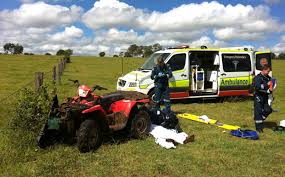There are around a quarter of a million quad bikes in Australia. They are now the biggest single killer on Australian farms, responsible for 15 on-farm fatalities in 2015. Between 2001 and 2012 there were more than 160 deaths associated with quad bikes, half of them resulting from rollovers.
Overall, thirty on-farm deaths were reported in the Australian media in the first six months of 2016, as well as 44 non-fatal incidents. Apart from quad bikes, the other major risks are tractors and other farm vehicles, unguarded machinery, animal handling and mustering.
Some people regard the results of research on the effectiveness of roll-bars on quads as inconclusive. Nevertheless Worksafe Victoria is tightening the rules so that they may be banned in workplaces unless appropriate rollover protection is fitted. Farmers will be required to fit crush-protection devices to quad bikes or face heavy fines if there is a rollover causing injury or death of an employee using such a vehicle.
The cost of a rollover protection system (about $700) will no longer be considered a reasonable excuse not to have the system installed.

As with other issues of this type, it is not sensible to rely only on technical or engineering fixes. It’s also about behaviour and attitudes to risk. Many organisations, including the Rural Industries Research and Development Corporation’s Primary Industries Health and Safety Partnership (PIHSP), are urging farmers to attend training courses about safe riding, following manufacturers’ instructions and behavioural matters like wearing helmets.
There is a significant divide between what might be called ‘organisational work’ on this issue and the practical experiences and views of people in the paddock. Some of the latter were canvassed in a recent fireside chat I had at Sue’s place in Forbes.
By definition, many of the people involved with organisations working on such an issue are unlikely to be practising farmers. This raises concerns among farmers about whether those people have sufficient knowledge about what it’s actually like in the field.
The practical views expressed at the fireside by Tony and Michael included the following.
The mandatory wearing of helmets tends to make drivers feel they are ‘unbreakable’, thereby changing their perception of risk.
Banning kids from using bikes is impractical, given the pleasure and utility they provide and given the cultural history of kids learning to drive on farms.
Children will always play a vital role as labour on family farms – often from a young age. Much of what they do requires mobility, whether by bike, quad, horse or motor vehicle, all of which are potentially dangerous. In an area that is otherwise relatively well-researched, this is something that merits further specific attention.
However well-prepared and careful farmers and their immediate family members are, there are always the risks associated with visitors.
If there is any large-scale success in limiting the use of quad bikes, it would mean a return to motorbikes and horses – which are equally risky.
Access ladders on the outside of silos have to be high enough to be out of reach of children. But this means that the first step cannot be accessed by an adult’s foot, requiring an extension ladder which has to be locked in place out of a child’s reach. That means searching for a key – – !!
Drivers of livestock B-doubles may refuse to wear a harness when working on the top deck in the belief that, should they fall, their safety would be even more seriously compromised by being in a harness.
Worksafe agencies seem to be unwilling or unable to specify standards which must not be breached – but are never slow to take a farmer to task if something goes wrong. This is illustrated by developments in Victoria which are not simple and categorical (ie mandatory) but dependent on retrospective considerations if and when there has been an accident.
The equivocal nature of some of this regulation is demonstrated by the fact that It is apparently possible for a farmer to sign a stat.dec. with the worksafe agency to formally acknowledge that they are knowingly undertaking action beyond some specified limit of risk. (If true, this is bizarre.)
Because of the paperwork involved, the farmer may be discouraged from developing, updating and putting into operation a workplace health and safety plan.
It’s clear that the involvement of children and visitors are two of the greatest challenges.
Tony: “The farm people may have done the right thing and learned the right way but then city friends come to stay. When they arrive their kids, like young dogs, bounce out of the car looking for exciting things to do and riding the 4 wheeler is the top of the list.”
“Proposals for regulation need to be put to groups of practising farmers for input. Farmers need clear paths for teaching the safety aspects so that if an accident happens and leads to litigation, the farmer’s teaching methods are recognised.”
“Most farms have protocols that everybody signs and these need to able to be upgraded quickly and simply when there are new regulations.”
One of the take-home messages is that all parties involved need to have patience with each other, to listen carefully, to observe realities in the field, and by these means to strike the right balance between regulation and the practicalities of farm work.
Everyone agrees that 50 or 60 on-farm deaths a year is a tragedy we should work to avoid.
Note: Quad bike safety and the realities of farm life was originally published at aggravations.org on 20 July 2016.
